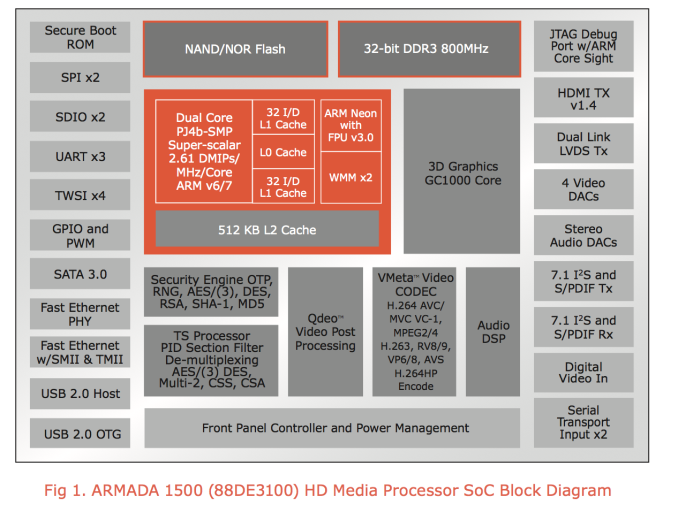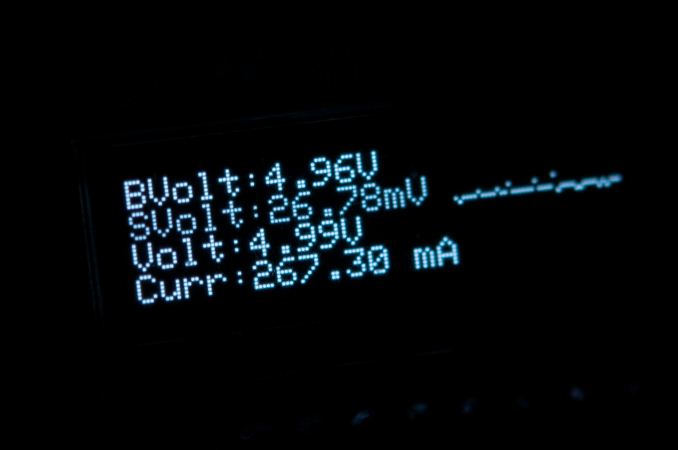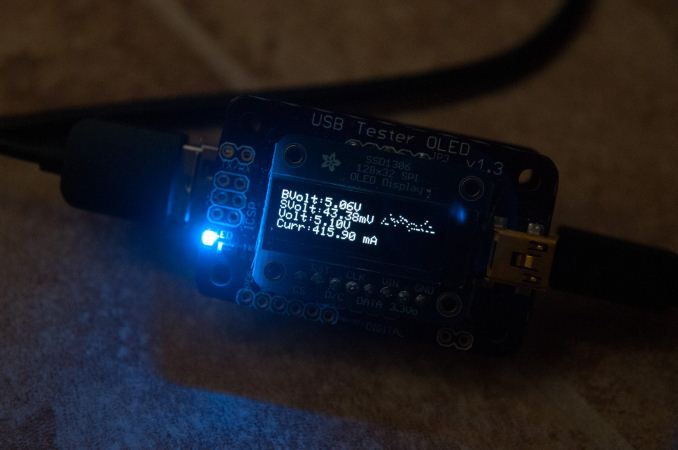Google Chromecast Review - An Awesome $35 HDMI Dongle
by Brian Klug on July 29, 2013 9:45 PM EST- Posted in
- Smartphones
- Media Player
- Android
- Mobile
- HDMI
- Chrome
- Tablets
- Chromecast
Inside Chromecast
Inside the Chromecast it’s also a simple affair, I took a look at the FCC disclosure for the Chromecast which had internal images up right after the event, and noted inclusion of a Marvell 88DE3005 SoC and AzureWave NH–387 WiFi combo chip. On the backside is 512 MB of Micron DDR3L memory and 2 GB of flash. The antenna for the WiFi combo is printed on the PCB off to the side, there’s no diversity or anything special, just a single PCB antenna.
The Chromecast supports just 802.11b/g/n (2.4 GHz), sadly no 5 GHz is included. That’s somewhat alarming if you’re in an area where 2.4 GHz is congested to the point of being unusable (just about any major urban area), and even more so since streaming applications demand a good QoS for good experience. I have no doubt that 2.4 GHz-only was chosen for cost reasons here, but I would’ve gladly paid $5–10 more for 5 GHz and eliminating that as a potential problem.
Best I can tell, the Marvell 88DE3005 is a cut down, perhaps binned version of the 88DE3100 SoC that has shipped in Google TV for some time now with just a single CPU core enabled. Some hacking done by enthusiasts has confirmed from /proc/cpuinfo that only a single core is visible to the OS, and that the Chromecast also interestingly enough really runs Android, not Chrome, and includes a build.prop file like you’d expect an Android device to.
Google no doubt chose this Marvell SoC in part thanks to the presence of hardware VP8 decode, and I have no doubt YouTube on the device brings down VP8 versions of videos when available, and the Chrome tab to Chromecast streaming uses VP8 as well. Of course there’s hardware decode of H.264 High Profile onboard as well for Netflix and other YouTube videos without VP8 versions. Google lists the supported codecs on their Google Cast SDK page.
Back when the power situation was unknown and still steeped in conflicting information about HDMI power delivery (again, it can't be powered by MHL-HDMI ports which can supply up to 500 mA at present spec, and HDMI doesn't supply enough current, just 50mA), I set about measuring power. I have a handy USB power meter which sits in line with devices and shows a small graph as well as data on its OLED display. I stuck the meter in line between the microUSB power supply provided with Chromecast, and the Chromecast, and measured around 420 mA at peak while decoding either a 1080p Netflix stream or Chrome tab streamed to it, and around 250 mA at idle. All of those are at 5 V, so at peak the Chromecast draws around 2 watts, at idle around 1 watt. Of course if the Chromecast is plugged into your TV’s USB port, chances are when the TV is off power is cut to USB, so idle really is completely off. It’s obvious to me that Chromecast definitely leverages that hardware decoder for both VP8 and H.264 processing to get these very low power numbers.


-004_575px.jpg)
-003_575px.jpg)











105 Comments
View All Comments
dvinnen - Monday, July 29, 2013 - link
Looking at it, the WiFi chip supports bluetooth 3.0. If google enabled controlling it via bluetooth it would be awesome for travel. Not sure that is possible though with he bluetooth specBrazos - Monday, July 29, 2013 - link
I assume this would work if plugged into a HDMI port on my AVI receiver (so I can enjoy sound thru my stereo)? Only problem might be the wireless connection due to it's location in the rear of the receiver. HDMI extension cable?Brian Klug - Monday, July 29, 2013 - link
That's exactly what I did, even on the floor/close to it (bottom shelf of the media cabinet) it works fine.-Brian
savagemike - Monday, July 29, 2013 - link
Would love an article on the miracast week you've had. Been thinking about trying that out and would love to hear more about the pitfalls.Given the new golden-child Nexus 7 (2013) apparently supports it that would be a great context for an article.
joeballow - Monday, July 29, 2013 - link
I do plan on getting one, but I wish they made a wired version with ethernet instead of wifi. I live in a crowded apartment building and prefer to hard wire anything that isn't mobile. It seems they could hit the same price point by dropping wifi and adding ethernet unless wifi is already integrated into the chip? If that's the case I'd pay $10 more for a wired/wireless version.LeftSide - Monday, July 29, 2013 - link
Just got mine in the mail. It's quite useful for $35, and if more developers get on board it could be great.Alketi - Monday, July 29, 2013 - link
Brian, if your attached pictures are any indication, you WANT a bright LED behind your TV screen.It provides a constant level ambient lighting, which allows your eyes to adjust, rather than be carried solely by the brightness of each TV/Movie scene.
Brian Klug - Tuesday, July 30, 2013 - link
Well that's true, but not when I'm in my bedroom and the TV/lights are off and I'm trying to sleep, and the Chromecast lights up a corner of the room. Seriously, the thing is BRIGHT!-Brian
ioconnor - Monday, July 29, 2013 - link
What does this thing do? All I got from skimming was that it wasn't some other product. And that whatever it is suppose to do might not be done. Yet.Better yet go back to talking about computers. That I can understand.
Kepe - Thursday, August 1, 2013 - link
Eh.. Perhaps you should read the article properly before commenting you don't understand it.